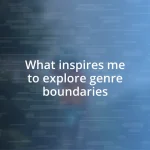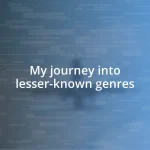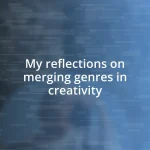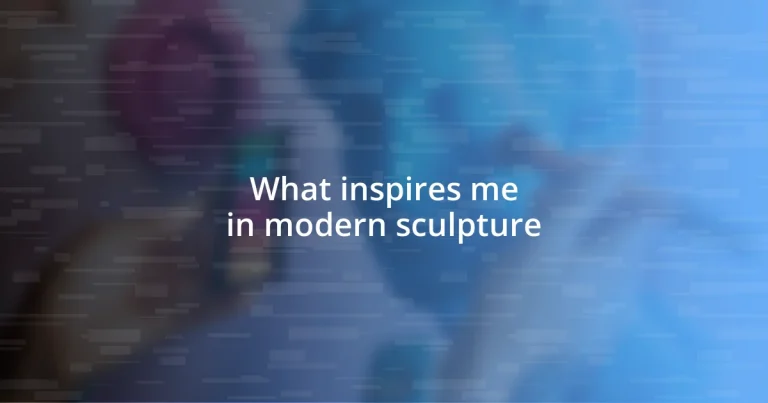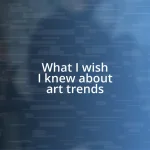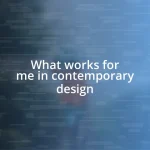Key takeaways:
- Modern sculpture challenges traditional forms, emphasizing emotional engagement and contemporary themes such as identity, nature, and technology.
- Key figures like Henry Moore and Louise Bourgeois illustrate how innovative techniques and personal narratives can profoundly influence viewers’ interpretations of art.
- Exploring local art scenes fosters community connections and encourages dialogue, showcasing how the environment shapes artistic expression and invites reflection on consumption and creativity.
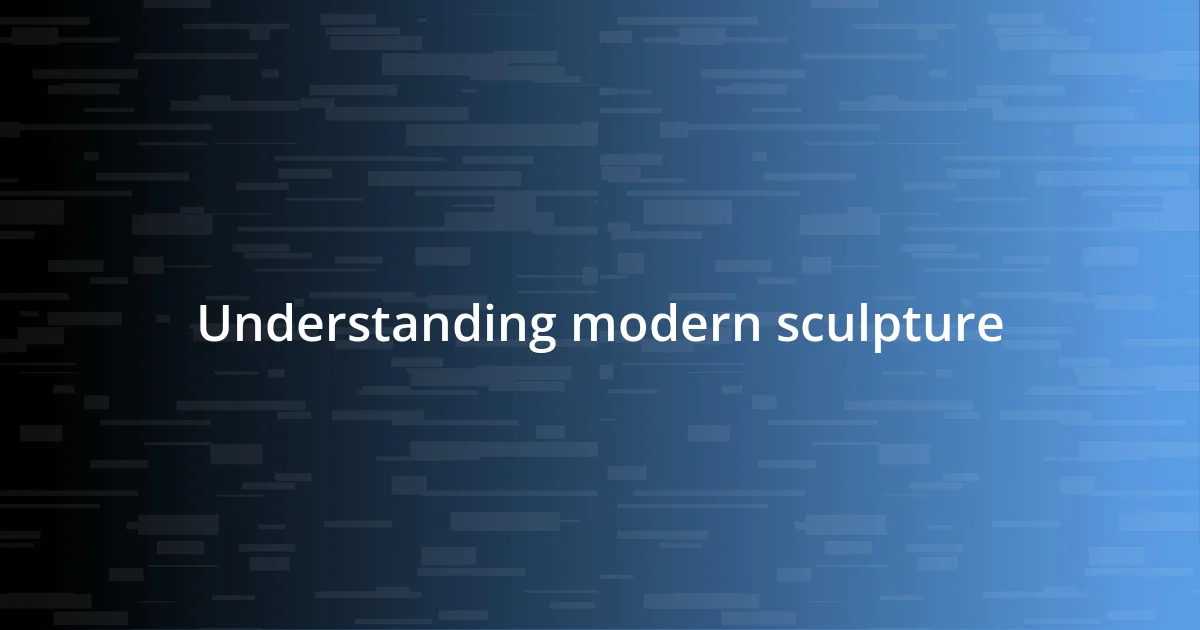
Understanding modern sculpture
Modern sculpture offers a fascinating departure from traditional forms, pushing boundaries and inviting fresh interpretations. I remember standing before a large abstract piece in a gallery, feeling both bewildered and captivated. What was the artist trying to convey? This complexity often drives my interest; I find that the ambiguity in modern works encourages viewers to engage with their own emotions and perspectives.
While traditional sculptures often represented recognizable figures or narratives, modern sculpture embraces materials and methods that reflect contemporary life. I once visited an installation that featured recycled materials intertwined into a mesmerizing form. The experience resonated deeply with me, highlighting how art can comment on environmental issues while simultaneously celebrating creativity. Isn’t it intriguing how artists can communicate so much through their choice of medium?
The emotional response elicited by modern sculpture can be strikingly personal. I’ve walked past pieces that felt jarring at first glance, only to revisit them days later with a newfound appreciation. This evolving relationship with art reminds me that modern sculpture is not just about the object itself; it’s also about the dialogue it sparks within us. How often do we allow ourselves to reflect on our feelings when we confront these unconventional forms?
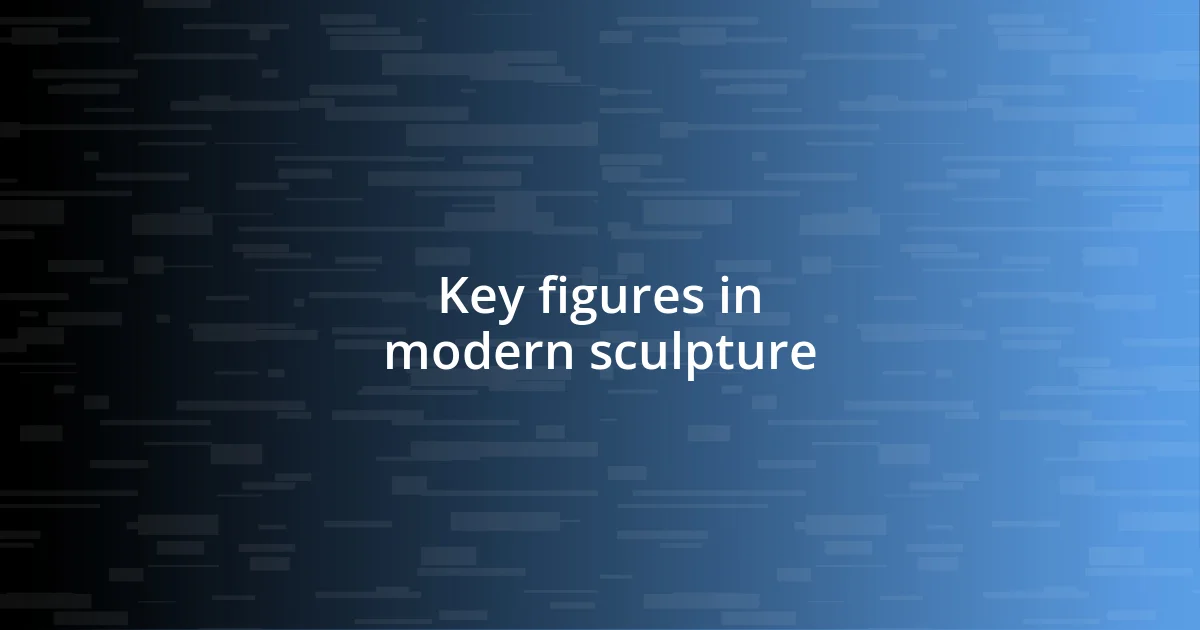
Key figures in modern sculpture
Some key figures in modern sculpture have profoundly shaped the art world with their innovative approaches and unique insights. I often find myself reflecting on the works of artists like Henry Moore and Barbara Hepworth, who brilliantly melded organic forms with a sense of intimacy. Their pieces resonate with me because they evoke both strength and vulnerability, encouraging viewers to contemplate the human experience through abstract forms.
Here are a few influential artists in modern sculpture:
- Henry Moore: Known for his massive, abstract forms that often resemble the human figure, he explored the relationship between sculpture and its surrounding environment.
- Barbara Hepworth: A pioneer of modernist sculpture, her work often integrated natural materials, evoking a sense of harmony with nature.
- Isamu Noguchi: His exploration of space and light in sculpture creates a gentle interaction between the art and its surroundings.
- Louise Bourgeois: With her deeply personal and emotionally charged works, she explored themes of femininity, family, and the subconscious.
- Alberto Giacometti: Famous for his elongated human figures, Giacometti’s work reflects themes of isolation and existential angst, resonating with the human condition.
When I recently encountered a stunning piece by Louise Bourgeois, the raw emotion in her work struck a chord within me. Each curve and contour seemed to narrate a story of intricacies and struggles, prompting me to pause and reflect on my relationships and experiences. It’s artists like Bourgeois who remind me how powerful modern sculpture can be, transcending the mere visual to touch the heart and mind in ways that are incredibly profound.
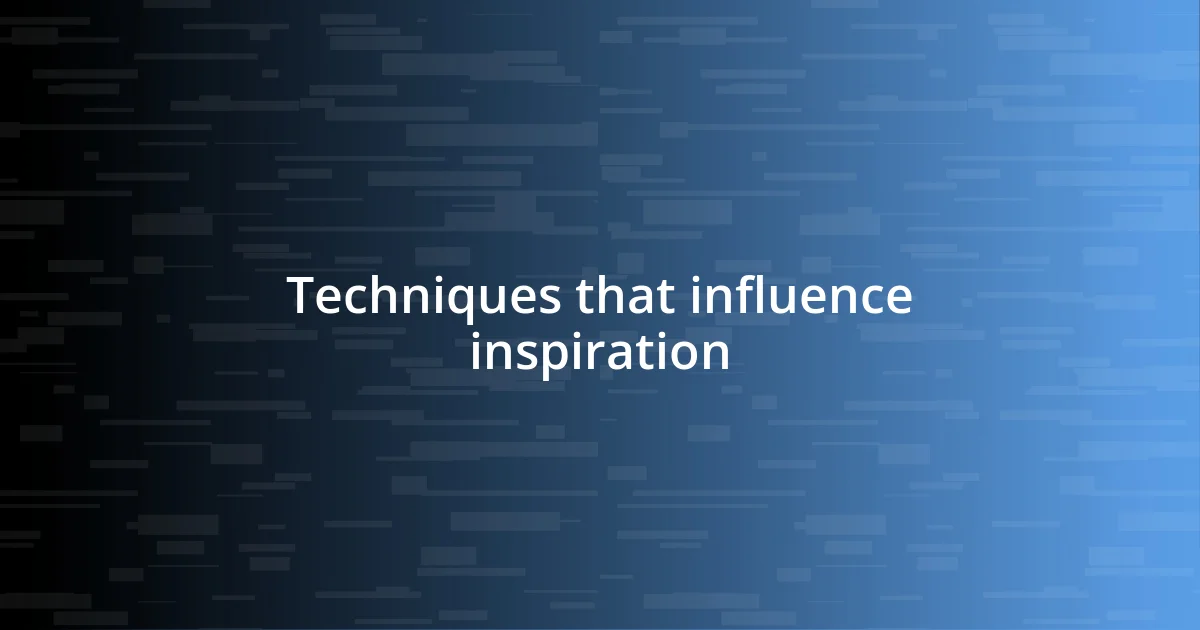
Techniques that influence inspiration
Techniques in modern sculpture are deeply intertwined with the inspiration they evoke in both artists and viewers. For instance, the use of mixed media in contemporary works often surprises me; it allows artists to blend materials like metal, glass, and found objects. I recall encountering a stunning sculpture that combined industrial components with natural forms, which sparked a conversation in my mind about the harmony—or discord—between nature and technology. This technique not only showcases creativity but also invites us to ponder our relationship with the world around us.
Another technique that captivates me is the exploration of negative space. I once stood in front of a sculpture that emphasized voids rather than mass, drawing attention to what was absent rather than what was present. This clever use of negative space made me feel an unexpected emptiness that resonated with my own experiences of loss and longing. It’s fascinating how such techniques can create an emotional landscape—a silent dialogue between the piece and its audience.
Gestural techniques in sculpting can also be profoundly moving. I remember watching a sculptor at work, his hands deftly shaping clay with what seemed like both spontaneity and intent. Each mark he made felt personal, transforming the material into a vivid expression of himself. This reminded me that art is often a reflection of our innermost thoughts and feelings, allowing a glimpse into the artist’s psyche. When the final piece emerged from those raw materials, it felt like more than a sculpture; it was a story—an intimate portrayal of the artist’s journey.
| Technique | Influence on Inspiration |
|---|---|
| Mixed Media | Combines different materials, prompting reflections on the relationship between nature and technology. |
| Negative Space | Highlights absence, evoking feelings of loss and facilitating personal connections. |
| Gestural Technique | Expresses personal emotions through the sculpting process, creating a narrative of the artist’s experience. |
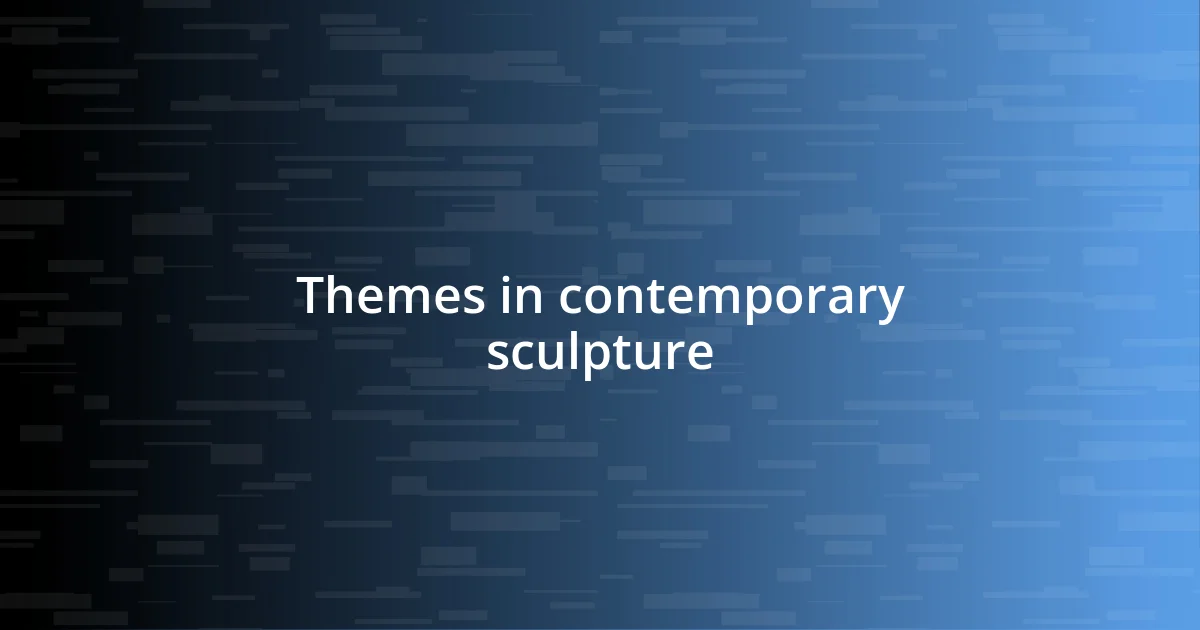
Themes in contemporary sculpture
Contemporary sculpture often explores themes such as identity and social issues, prompting me to reflect on my personal experiences and the world around me. For example, when I encountered an installation that depicted the struggles of refugees, it struck a deep chord within me. The powerful imagery compelled me to consider how art can serve not only as a medium of expression but also as a means of raising awareness about pressing societal issues. Isn’t it remarkable how a simple sculpture can ignite a dialogue about human rights?
Another theme that fascinates me is the interaction between art and technology. I recently saw a piece that utilized augmented reality, allowing viewers to engage with the sculpture in unexpected ways. This blend of physical and digital dimensions made me question how technology alters our perception of art. How does connecting contemporary sculpture with tech challenge our understanding of artistic boundaries? This merging of mediums invites us to rethink not only what sculpture can be, but also how it can evolve in our rapidly changing world.
Nature is also a profound theme in modern sculpture. I remember visiting a park where artists used natural materials to create pieces that seamlessly blended with the environment. Standing before a wooden sculpture that mimicked the surrounding trees, I felt an innate connection to the earth. It made me wonder—how does our relationship with nature shape our artistic expressions? These artworks remind us of our roots, offering a space to reconnect with the natural world amidst the hustle of daily life.
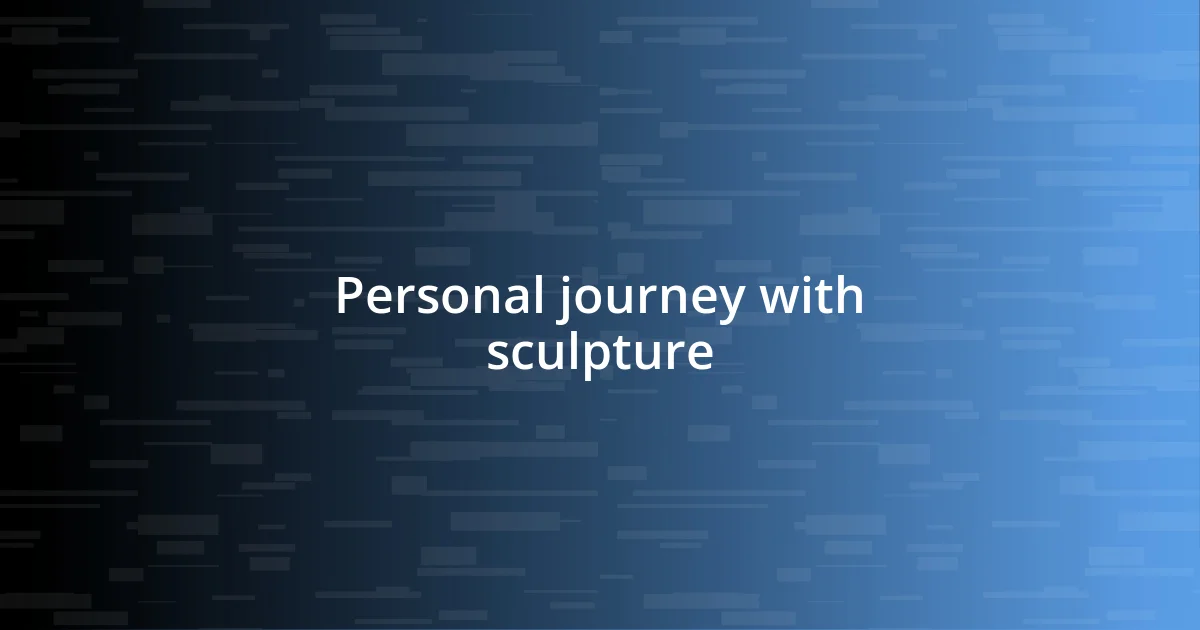
Personal journey with sculpture
I’ve always felt a magnetic pull towards sculpture, particularly during my early visits to art museums. One afternoon in my teens, while wandering through an exhibition, I stumbled across a towering figure that radiated strength and vulnerability at the same time. I remember feeling a rush of inspiration as I stood there, struck by how the artist had captured complex emotions in solid form. It made me reflect on the physicality of our experiences—how sometimes, we embody our struggles in ways that words simply can’t express.
Years later, I found myself experimenting with clay in a local art class, trying to translate my feelings onto the medium. There was a moment when I accidentally broke a piece I was working on, and instead of feeling defeated, I began to see beauty in the fragmented shapes. I realized then that sculpture, much like life, is often about embracing imperfections. This breakthrough taught me that every flaw could tell a story—a lesson I carry with me in both art and daily life.
It’s fascinating to see how my journey with sculpture intertwines with my understanding of self. I vividly remember a project where I incorporated personal artifacts into my work—items I held dear yet hadn’t realized were burdening me. As I sculpted, I felt a sense of release, almost like unearthing parts of my identity that had long been buried. Why do we hold onto things that weigh us down, and how can art become a catalyst for liberation? Embracing this journey has not only reshaped my perspective on sculpture but has also deepened my connection to my own story.
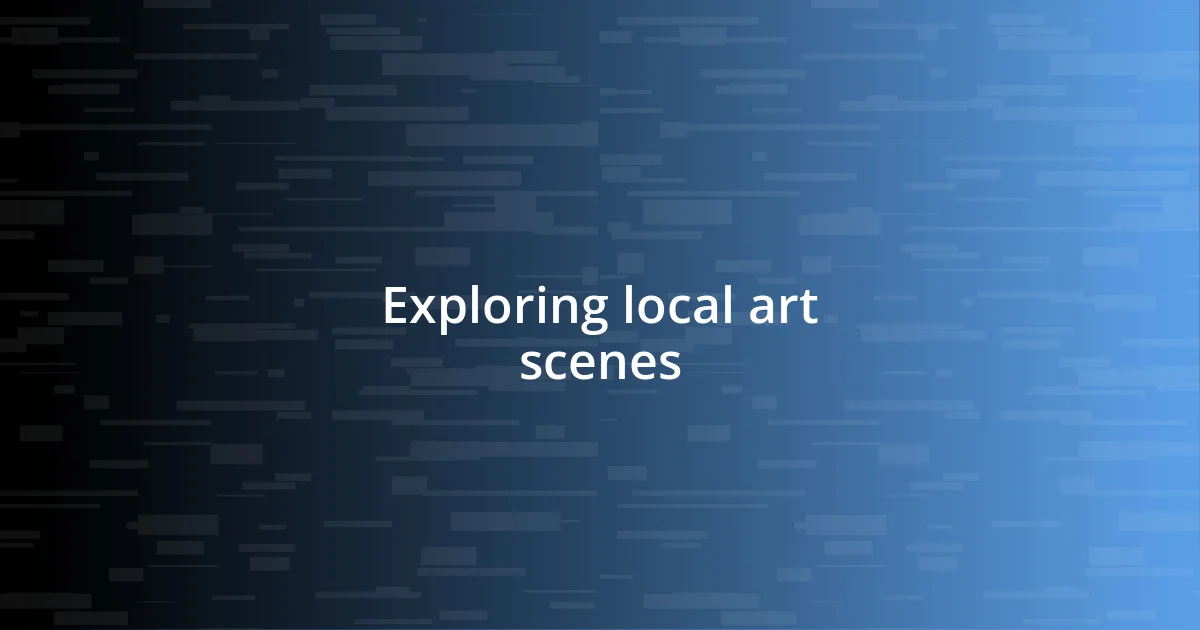
Exploring local art scenes
Exploring local art scenes provides a window into the soul of a community. I’ll never forget the local gallery opening I attended last summer. The energy was palpable as artists mingled with guests, sharing stories behind their creations. It struck me how these gatherings not only showcase talent but also foster connections and encourage dialogue. Have you ever felt a sense of belonging in a room full of strangers bound by a shared appreciation for art?
In my own experience, visiting a neighborhood studio filled with vibrant sculptures opened my eyes to the grassroots nature of contemporary art. There was something special about seeing artists passionately working among their creations, inviting visitors to witness the process. One artist, in particular, explained how his work was inspired by local landscapes, intertwining his personal journey with the community’s identity. This interplay between art and locality fuels my fascination—how can the spaces we inhabit shape the art we create?
Sometimes, local art scenes feel like a treasure hunt waiting to be explored. I recall discovering a pop-up installation in an alleyway that featured sculptures made entirely from reclaimed materials. The beauty of these pieces, crafted from discarded items, resonated deeply with me. It prompted lingering questions: How can we redefine waste through creativity? What stories do these pieces whisper about our consumption habits? Engaging with local art connects us not only to the artist’s vision but to the larger narrative of our shared environment.




